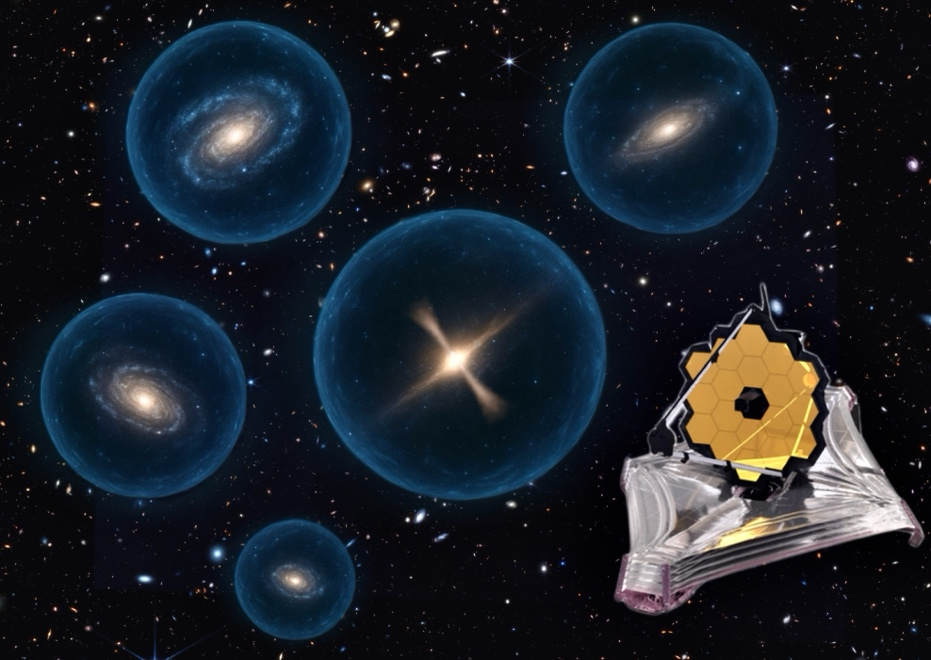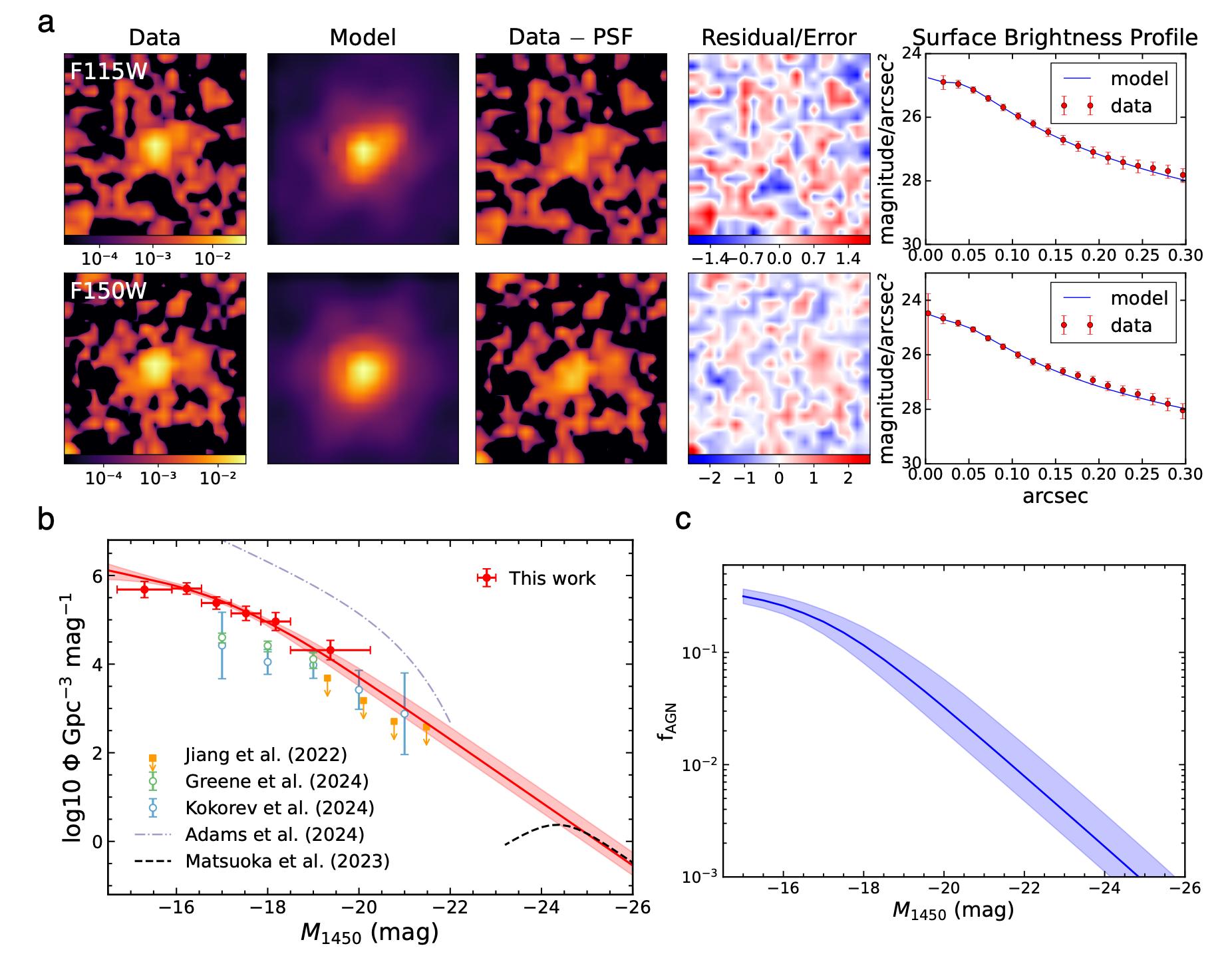A team led by Professor Linhua Jiang and PhD student Danyang Jiang at the Kavli Institute for Astronomy and Astrophysics and School of Physics at Peking University used the James Webb Space Telescope (JWST) to conclusively rule out the possibility of AGNs being the dominant ionizing sources during the peak period of reionization, a transformative epoch in the history of our universe. Star-forming galaxies must have provided the primary ionizing photons for cosmic reionization The study, titled “AGNs ruled out as the dominant source of cosmic reionization,” was published online on October 7, 2025, in Nature Astronomy.

Figure 1. Artistic illustration: AGNs and galaxies contributing to cosmic reionization (Image created by Danyang Jiang; part of the image source: NASA).
Cosmic reionization occurred around 13 billion years ago (redshift greater than 6), when the universe was approximately 800 million years old. With the onset of reionization, the earliest stars, galaxies, and AGNs (or quasars) began to form. These objects emitted ultraviolet Lyman continuum photons which gradually ionized the hydrogen in the intergalactic medium (IGM). This process, known as cosmic reionization, is one of the most pivotal phases in the history of the universe (Figure 1). The reionization process is vast and complex, and one of the core scientific questions is the source of the ionizing energy, specifically which objects provided sufficient ultraviolet photons for reionization. Two main candidates are generally considered: either AGNs driven by supermassive black holes, or star-forming galaxies rich in massive stars.
For a long time, the relative contribution of AGNs and galaxies to cosmic reionization has remained unclear. The primary uncertainty for galaxies is from the unknown escape fraction of ionizing photons. Observations show that only a few percent of ionizing photons from low- and medium-redshift galaxies escape into the IGM, with the majority being absorbed (or scattered) by the galaxies themselves or their surrounding medium. The escape fraction for high-redshift galaxies is difficult to directly measure due to the absorption by the IGM. On the other hand, the contribution of high-redshift AGNs is also debated. While many high-luminosity AGNs have been discovered, little is known about the numerous faint AGNs that likely dominate in number. Some previous studies suggested that the number of high-redshift AGNs is insufficient to provide enough ionizing photons. Recently, JWST has discovered many faint AGN candidates at redshifts greater than 4, including mysterious “small red dots”. It remained uncertain whether the ultraviolet photon radiation from these sources comes from AGNs. If all candidates are included, the spatial density of faint-end AGNs would be 1-2 orders of magnitude higher than what was expected, suggesting that they may play a key role on reionization.
Using JWST deep field observations, the team developed a new method to provide an absolute upper limit on the contribution of AGNs. First, they utilized JWST multi-band images, combining photometric redshifts and the color selection, to isolate galaxies and AGN with redshifts between 7.15 and 7.75 (the peak period of reionization) from low-redshift objects. Then, the team performed image decomposition (Figure 2a) on all selected high-redshift objects, calculating the fraction of point-source components. Assuming all point-source components are AGNs, the team derived a strict upper limit on the number density of AGNs. This method is independent of the identification of AGN candidates and reaches unprecedented detection depths, accounting for all potentially existing faint AGNs.

Figure 2. Image decomposition of high-redshift objects and the contribution of AGNs to cosmic reionization. (a) An example of image decomposition; (b) The luminosity function of high-redshift AGNs; (c) The maximum contribution of AGNs to reionization is 32%.
Based on the method outlined above, the team constructed the luminosity function of faint AGNs from the candidate sample (Figure 2b). By calculating the total number of ionizing photons produced by AGNs and comparing it with the required number of ionizing photons to maintain the reionization in the redshift range, the team found that, under the most conservative assumptions, the contribution of AGNs to cosmic reionization does not exceed 32% (Figure 2c).
This result confirms that high-redshift galaxies are the primary contributors of ionizing photons during cosmic reionization, clarifies the main source of energy for reionization and provides strong observational constraints for theoretical models of cosmic reionization. In the future, in-depth studies of high-redshift galaxies will more comprehensively understand the physical mechanisms and redshift evolution of cosmic reionization. New-generation astronomical facilities, such as the Chinese Space Station Telescope, are expected to make significant progress in this frontier field.
This research was funded by National Science Foundation of China. This research is based on observations made with the NASA/ESA/CSA JWST. The data were obtained from MAST at the Space Telescope Science Institute, which is operated by the Association of Universities for Research in Astronomy, Inc., under NASA contract NAS 5-03127 for JWST.
Link to the paper:
https://www.nature.com/articles/s41550-025-02676-7